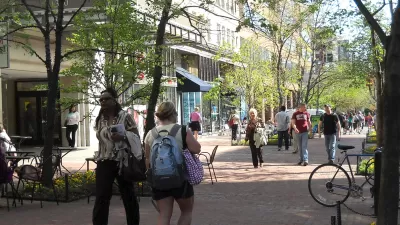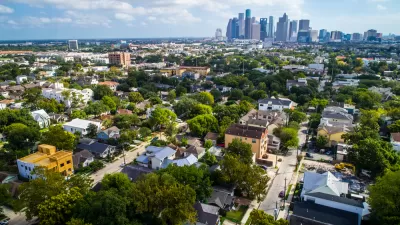If Detroit needs to be "rebuilt" or "reimagined," why not do so around a walkable, convenient ideal? A compact Motor City where essential goods and services are available within a 20-minute walk?

"Detroit Mayor Mike Duggan recently introduced the idea of rebuilding Detroit around the concept of the 20-minute neighborhood, where folks can walk or bike to everything they need outside of work." A valiant concept to be sure, but is it realistic?
Wayne State planning professor Robin Boyle writes, "a 20-minute neighborhood is an active, safe, walkable, convenient, predominantly residential neighborhood. A place where people can get most of their day-to-day goods and services — shopping with good food, access to transit, parks and schools — within a 20-minute walk."
Density is the deciding factor, but Detroit has become renowned for shedding its density. "The mayor's initial target neighborhoods: L6 (Livernois and McNichols), Southwest Detroit and West Village on the east side might work. But the key to extending the concept is density. Are there enough households, with sufficient disposable income, to sustain the shops, the local services? Are there enough children to keep the school open and thriving?"
Success will depend on fostering areas best suited to denser amenities, which means leaving other areas out. "The 20-minute neighborhood needs a residential density of somewhere between 15 and 20 households per acre to support local retail. Outside of the downtown/Midtown corridor and a select number of more dense, occupied neighborhoods, most of Detroit has a lower residential density."
FULL STORY: Could the 20-minute neighborhood work in Detroit?

Alabama: Trump Terminates Settlements for Black Communities Harmed By Raw Sewage
Trump deemed the landmark civil rights agreement “illegal DEI and environmental justice policy.”

Planetizen Federal Action Tracker
A weekly monitor of how Trump’s orders and actions are impacting planners and planning in America.

How Atlanta Built 7,000 Housing Units in 3 Years
The city’s comprehensive, neighborhood-focused housing strategy focuses on identifying properties and land that can be repurposed for housing and encouraging development in underserved neighborhoods.

In Both Crashes and Crime, Public Transportation is Far Safer than Driving
Contrary to popular assumptions, public transportation has far lower crash and crime rates than automobile travel. For safer communities, improve and encourage transit travel.

Report: Zoning Reforms Should Complement Nashville’s Ambitious Transit Plan
Without reform, restrictive zoning codes will limit the impact of the city’s planned transit expansion and could exclude some of the residents who depend on transit the most.

Judge Orders Release of Frozen IRA, IIJA Funding
The decision is a victory for environmental groups who charged that freezing funds for critical infrastructure and disaster response programs caused “real and irreparable harm” to communities.
Urban Design for Planners 1: Software Tools
This six-course series explores essential urban design concepts using open source software and equips planners with the tools they need to participate fully in the urban design process.
Planning for Universal Design
Learn the tools for implementing Universal Design in planning regulations.
Jessamine County Fiscal Court
Caltrans
Institute for Housing and Urban Development Studies (IHS)
City of Grandview
Harvard GSD Executive Education
Toledo-Lucas County Plan Commissions
Salt Lake City
NYU Wagner Graduate School of Public Service





























